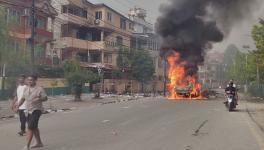Demonetisation: Promises Vs Reality
Demonetisation has vacuumed liquidity from a cash based economy that provides livelihood to more than half the population. The amount of Rs. 2,000 notes printed is a lot more than the Rs. 500 ones, causing lack of lower denomination notes in circulation. This was done under the pretense of curbing black money. However, seeing the latest figures given out by RBI, it’s evident that the promise was a farce. With almost all the demonetised money back into banks, it seems the black money has vanished into thin air. The adverse impact of the scheme can be evidently seen on the formal sector. But there is no measure that would reflect how the informal sector has been damaged. Not only the economy will shrink but the GDP too, would go down.
Rough Transcript:
Prabir: Hello and welcome to Newsclick. This program with Real news. We are discussing what’s happened to the Indian economy post the demonetization taking away 86% of the money in circulation and also not being able to put it back quick enough. We have with us Prof. Surajit Majumdar from Jawaharlal Nehru University, department of Economics. Surajit, putting it very simply, it seems the pace at which notes are being printed are slow. We have printed 2000 rupee notes which between the 2000 rupee notes and the next denomination which is widely available is 100 rupee notes. So we don’t seem to be able to use the 2000 rupee notes, and we are not printing 500 rupee notes fast enough. From all accounts we are going to take anything between 5 to 6 months to be able to put back 500 rupee notes in circulation which means that we still see shortage of cash in the economy. What’s going to happen to the Indian economy if the shortage persists which is now likely to be for next 3 to 6 months.
Surajit: Well, as far as the shortage of cash is concerned one very simple way in which one can look at it. Suppose you were to say that all the vehicles on the road today at this point of time have to be replaced with new ones. Would the production capacity of the country to produce those vehicles be able to replace them in a short period of time? No. Because that existing stock of vehicles has been produced over a long period of time. It is essentially the same thing with the currency. The currency in use today is something that has been produced over a… every year you add some bit to it. So basically you have a capacity to print what you need to add every year. And now suddenly you are having to replace practically the entire currency. And from the figures that have been put out by the RBI is quite clear that more than 55% of the value of the new currency put into circulation is 2000 rupee notes. That’s the minimum. It’s probably even higher than that which is not going to be sufficient. So you really have to now add currency of smaller denominations in the coming year which means more units and therefore the fact that it is going to take a long period of time is absolutely clear. I think the government has also accepted that they would not be able to reach even more than fifty percent replacement of the currency by 30th December.
Prabir: That’s why I said, that it doesn’t appear that they will be able to print the 500 rupee notes which they require fifteen billion of them and that would take, given the fact that they can only print all four presses put together can only print 3.3 billon pieces of notes per month.
Surajit: So therefore, the shortage of cash is going to be felt for a period of time, except the extent of the requirement of the cash comes down because economic activity itself has shrunk down. The consequence of this shortage is at least one important mode with which people make payments is not available with them in requisite quantity. And beyond a point it is not possible to shift to alternative modes of making payment.
Prabir: Surajit we have looked at the non cash transactions in the last month November, even that has come down. So it is not that it has increased to compensate for the lack of cash transactions.
Surajit: Actually because, if you have a situation where economic activity contracts because of the shortage of cash it is going to affect all transactions. That means the total volume of transactions, the value of transactions themselves have come down and therefore even non cash transactions may shrink as a result of the shortage of cash. So essentially the problem is this; that the amount of money that is available with people with which they can make payments is less. If the total value of payments that people can make is reduced, then the total value of payments that people can receive is also correspondingly reduced, because ultimately you receive what someone else pays. Which means that the total economic activities which involves buying and selling that can be sustained with this particular level of income, has to shrink.
Prabir: Are we looking at the economy in recession? Right now do you expect November, December which are the two months, which has felt the demonetization, the economy to actually shrink?
Surajit: I think definitely the economy will shrink and may shrink very significantly . I am not so certain whether our statistics about the economy will fully capture this in fact. Let me give an example of that. Suppose there is a rickshaw puller who used to transport people from one point to another point, and because of the shortage of cash some people decide to just walk that distance and don’t use that rickshaw any more. So there is that particular service, total production of that service, and the income that would have accrued to the rickshaw puller as a result of that activity virtually disappears completely for a period of time. Which statistical measure or system is actually going to capture that? Because a lot of our data comes from a very organized kind of units and we assume that normally there is some relationship between a set of transactions which we can record and transactions that we are not recording. But those ratios may not be valid for this particular context.
Prabir: So services part will be difficult to capture.Services like this. But if we look at industrial production, and we have looked now at Firozabad bangles, in Aligarh the lock industry; we looked in Moradabad at the brassware industry, Agra the footwear industry - precipitate drop in production. Aligarh has four thousand crores of annual income, ninety percent of the factories seem to be shut down. We are really seeing already, even what is captured is also being shut down. Are we also looking at these organized forms which are capturing some statistics or the other, also showing much lower production and therefore actually capturing that we have already entered into recession?
Surajit: Well let me put it this way. The organized units they are also taking a hit. It is not that organized units don’t take a hit. As far as industrial sector is concerned, the index of industrial production figures that came for October, which is before the demonetization, themselves showed that compared to the previous year production was down by two and half percent. And this has been going on for some period of time. So these sectors are also going to take a hit. What I am saying is, that in addition to that, even in industrial sector that are un- organized units, and the distribution of the extent of down turn between organized and unorganized sector units may not be in the same ratio in which normally production is distributed. And since we are going to estimate what’s going to happen in the unorganized sector often from what is there in organized sector, our data may not fully capture the extent of the decline that will take place in the GDP.
Prabir: But you are sure that GDP decline is going to take place in this quarter?
Surajit: Absolutely. Compared to what would happen in the normal year, this has to. There is no way in which you can withdraw such a large part of the currency from circulation and not see the effects of that in terms of contraction of GDP, because after all the production of GDP depends on the use of money.
Prabir: So while we discussed the black money coming back into the banks this is going to be a long process, money not coming back to the banks which was the initial expectation hasn’t happened, so the black money side the ledger seems to be rather bleak for Mr. Modi. But if on top of that we have a stagnation in the economy and in fact the contracts are treating it as recession, it appears, that it seems to be economically a very stupid move.
Surajit: Yes. So largely the opinion amongst economists is pretty unanimous and exceptionally so, it is never normally so unanimous on any matter, but this time it is, because everyone can understand that there are on the one side serious consequences, that you are going to derail the process of economic activity through which people generate their income, through which people find their work, and employment. So you are going to have that derailing effect and on that there is no dispute. You can quibble about the degree to which that will happen, but you can’t dispute that particular effect. On the other side, everyone realizes that the possible hit that the black economy could take from such a move was always minimal. That was a given, before the demonetization exercise. You didn’t need the exercise to know that that would be the result, for the simple reason that the amount of cash that is held by people is a very small fraction of the total income that is generated in a year. It’s a very small fraction of the total wealth that is held by people. So even if you do something as far as that cash is concerned, the effect on the black economy was not going to be severe that was in any case a given, right at the beginning. Therefore what you can only do is to disrupt the particular process. After all black incomes are not generated from a process which is completely delinked from the process by which other incomes are generated. They are not two distinct parts of the economy. They are interlinked parts of the economy. So it’s not just that those who earn black incomes, they may not be, or their black income may not be severely affected as the white income. Maybe. And the white income that is going to be affected more severely are of those who are the most vulnerable.
Prabir; You have already seen that none of the rich are standing in queues or spending sleepless nights, while people are. So that is already there. The poor have returned, a lot of daily wage workers have returned from the towns to their villages. This has been going on. But what kind of economic sense was there in the government? Who would have planned it? Do you think that they are singularly bereft of the economics, basic economics, or is it that they have a different kind of economics which you and I don’t know about and the world doesn’t know about?
Surajit: Well, if they have then of course, we don’t know about it. (laughs) But what I would say is this, a more realistic way of looking at it is this: that you knew that the effects on the black economy was not going to be significant . That was not the error, but perhaps the certainty with which you took that action. You knew it was not going to affect the black economy significantly, because that was not your intention in any case. You knew that the effects on the majority of the population in India would be pretty drastic and adverse. If after knowing that, these two things, you undertook such an action then perhaps it reflexes an attitude towards the Indian people, which is that the belief is that these Indian people you can hit at their basic requirements, put them into the conditions of adversity, and you can still fool them into thinking that what you are doing is for the benefit of the nation. So it requires an understanding, of true contempt for the people of this country for you to undertake this kind of action.
Prabir: Thank you very much. This is all the time we have for Newsclick today. Please keep watching Newsclick . Do subscribe to our website, our newsletter and also our facebook page.
Get the latest reports & analysis with people's perspective on Protests, movements & deep analytical videos, discussions of the current affairs in your Telegram app. Subscribe to NewsClick's Telegram channel & get Real-Time updates on stories, as they get published on our website.
























